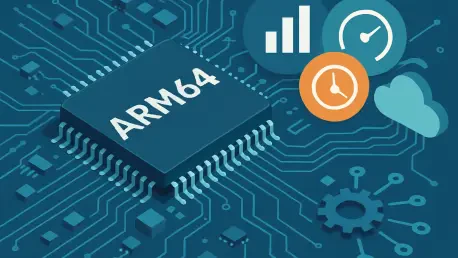In the ever-evolving landscape of cloud-native environments, Arm64-based servers have surged in popularity, driven by a compelling statistic: they often deliver up to 30 percent better price-performance ratios than traditional x86 architectures. This shift is reshaping data centers globally, as enterprises prioritize cost efficiency and scalability in their infrastructure. The adoption of Arm64 is not merely a trend but a response to the pressing need for high-performance computing solutions that can handle modern workloads without breaking budgets.
Energy efficiency stands as another cornerstone of Arm64’s appeal, with these processors consuming significantly less power compared to their x86 counterparts. This advantage aligns with the growing emphasis on sustainable computing practices, making Arm64 a preferred choice for organizations aiming to reduce their carbon footprint. Major cloud providers and enterprises are increasingly integrating Arm64 instances into their fleets, recognizing the long-term benefits of lower operational costs.
Key innovators like Ampere Computing are at the forefront of this transformation with their Altra family of processors, which are engineered for cloud workloads with high core counts and optimized performance. Their contributions are pushing the boundaries of what Arm64 can achieve, setting new benchmarks in the industry. However, as adoption grows, so does the demand for specialized observability tools tailored to maintain visibility and performance monitoring across heterogeneous systems that combine multiple architectures.
OpenTelemetry’s Role in Cross-Architecture Observability
Key Trends Shaping Observability Needs
The rise of heterogeneous computing environments, where Arm64 and x86 architectures coexist, has created a complex landscape for IT operators and developers. This diversity in hardware demands observability solutions capable of providing consistent insights regardless of the underlying platform. Without such tools, pinpointing performance bottlenecks or system anomalies becomes a daunting task in mixed-architecture setups.
A parallel trend is the heightened focus on performance optimization and cost efficiency in server hardware selection. Companies are scrutinizing every aspect of their infrastructure to maximize return on investment, pushing observability frameworks to deliver granular data on resource utilization. This scrutiny is especially critical in environments leveraging Arm64 for its economic advantages, where every efficiency gain translates to significant savings.
Additionally, there is a noticeable shift toward collaborative innovation between hardware manufacturers and software communities. This partnership model ensures that tools evolve in tandem with hardware advancements, addressing compatibility issues early in the development cycle. The increasing importance of comprehensive testing to uncover architecture-specific issues, such as race conditions, further underscores the need for integrated efforts across sectors.
Impact and Progress in Arm64 Support
As of 2025, OpenTelemetry has made substantial strides in supporting Arm64 deployments, overcoming initial gaps that existed in earlier years. Performance metrics reveal a notable 15 percent cost reduction in deployment instances on Arm64 systems, a testament to the framework’s optimization for this architecture. Such savings are driving broader adoption among cost-conscious enterprises seeking competitive edges.
Looking ahead, projections indicate that OpenTelemetry will maintain its momentum, with plans to solidify tier-1 support for Arm64 within the next two years. This commitment ensures equitable customer support across all major architectures, fostering trust and reliability among users. The focus on parity with x86 support reflects a strategic vision for inclusive observability solutions.
Beyond immediate benefits, Arm64 testing within OpenTelemetry has proven to enhance overall software stability across platforms. By identifying and resolving architecture-specific issues during development, the framework mitigates risks that could affect end-users on any system. This holistic improvement in code quality positions OpenTelemetry as a cornerstone of modern observability practices.
Challenges in Adapting OpenTelemetry for Arm64
Adapting OpenTelemetry for Arm64 architecture presents intricate challenges rooted in cross-architecture compatibility. Differing processor pipelines and core counts—often reaching up to 128 or 256 on Arm64 compared to x86’s typically lower numbers—create unique execution behaviors that software must account for. These variations can lead to unexpected performance issues if not addressed during the development phase.
Another hurdle lies in third-party frameworks and Docker images that inaccurately claim Arm compliance. Many of these tools merely repackage x86 code without proper validation, leading to compatibility failures in real-world deployments. Such discrepancies highlight a broader industry challenge of ensuring genuine support for diverse hardware environments beyond superficial claims.
Historically, developers have often assumed uniform software behavior across architectures, an oversight that masks latent issues like race conditions. Overcoming this requires a paradigm shift toward rigorous testing on actual Arm64 hardware rather than relying on emulation or assumptions. Implementing such testing strategies is essential to guarantee code integrity and reliability in production environments.
Collaborative Innovation with Ampere Computing and Beyond
Ampere Computing has played a pivotal role in advancing OpenTelemetry’s Arm64 capabilities by donating Altra-powered servers for development and testing. This hardware support has enabled the OpenTelemetry team to fine-tune instrumentation and metrics collection specifically for Arm64, addressing critical compatibility gaps. The collaboration exemplifies how hardware providers can accelerate software advancements through tangible contributions.
Partnerships extend beyond hardware, with the integration of Actuated’s microVM-based CI/CD pipelines ensuring secure and consistent testing across architectures. These isolated environments mitigate risks associated with container builds, streamlining the validation process for both Arm64 and x86 codebases. Such innovative approaches are setting new standards for development workflows in heterogeneous computing landscapes.
The impact of these collaborative models is evident in the accelerated pace of development and enhanced code integrity for OpenTelemetry. By uniting hardware expertise with software ingenuity, these alliances are paving the way for robust observability tools that cater to diverse infrastructure needs. The success of this model serves as a blueprint for future industry collaborations aiming to tackle emerging technological challenges.
Future Outlook for Arm64 and Observability Tools
Emerging trends point toward sustainable computing practices, with energy-efficient architectures like Arm64 gaining prominence in global data centers. As organizations prioritize environmental responsibility alongside performance, the adoption of such processors is expected to grow, influencing the design of observability tools. This alignment with sustainability goals will likely shape infrastructure strategies in the coming years.
Potential disruptors in hardware and software integration are also on the horizon, with advancements in chip design and observability algorithms poised to redefine the landscape. These innovations could introduce new paradigms for monitoring and managing mixed-architecture environments, challenging existing frameworks to adapt swiftly. Staying ahead of these shifts will be crucial for maintaining competitive relevance.
OpenTelemetry is well-positioned to lead in cross-architecture support, evolving into a benchmark for observability solutions. Its ongoing enhancements for Arm64, coupled with a commitment to universal compatibility, suggest a future where seamless monitoring across diverse systems becomes the norm. Global economic conditions and technological innovation will continue to drive growth areas for Arm64 adoption, reinforcing the need for adaptive tools.
Conclusion and Strategic Recommendations
Reflecting on the journey, OpenTelemetry’s adaptation to Arm64 with Ampere Computing’s support marks a significant milestone in enhancing code integrity and performance across diverse architectures. The collaboration tackled complex compatibility challenges, delivering measurable benefits like cost reductions and improved stability for end-users. This effort set a precedent for how strategic partnerships can address emerging needs in cloud-native computing.
Moving forward, sustained collaboration between hardware vendors and software communities emerges as a critical next step to ensure observability tools keep pace with architectural advancements. Investing in comprehensive testing environments on actual hardware proves essential to preempt issues before they impact production systems. Additionally, fostering industry-wide standards for genuine architecture compliance in third-party tools becomes a priority to eliminate false claims and build trust.
Lastly, a forward-looking consideration involves anticipating the integration of next-generation hardware innovations into observability frameworks. By proactively aligning development roadmaps with hardware trends, stakeholders can unlock further efficiencies and capabilities. These actionable steps promise to solidify the role of observability solutions in supporting the dynamic and diverse landscape of modern computing environments.









